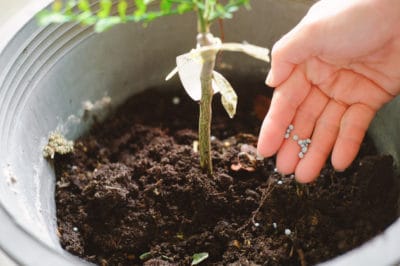Expert gardener’s tip: Wherever lemon trees grow in USDA plant hardiness zones 9 through 11, good drainage is an absolute must. That’s one thing even the best fertilizer can’t supply.
What’s the Best Lemon Tree Fertilizer, and Why?
Using an organic citrus fertilizer will improve the soil and help your lemon tree in ways that chemical fertilizers just don’t:
- An organic fertilizer texturizes the soil so that more oxygen reaches the tree’s root system and the earthworms that break organic matter down.
- An organic fertilizer feeds the microbes that convert the soil’s nutrients into root-absorbable compounds.
- An organic fertilizer releases small amounts of nutrients over a long time, so your tree needs far fewer applications.
- An organic fertilizer won’t contaminate the soil with root-destroying mineral salts. This is especially good news if you’re growing a potted lemon tree.
Still not convinced? Then consider this: Given proper care, a lemon tree can live 100 or more years. Over that time, the excess nutrients from chemical fertilizers may pollute local waterways so badly that they develop dead zones where fish can’t survive.
What to Look For in an Organic Lemon Tree Fertilizer
The ideal choice is a granular, slow-release formula with two or three times as much nitrogen (N) as potassium and phosphorous (P and K). For example, its label numbers might read 3-1-1 or 6-3-3. It would also contain trace minerals, including iron, boron, calcium, copper, zinc and manganese.
Fertilizing Your Lemon Tree
Replenish your lemon tree’s nutrients three times during the growing season:
- Just before it blooms in late winter or early spring
- As soon as it finishes flowering
- In early to mid-summer
Fertilizing any later may stimulate frost-tender new growth at the expense of properly developed fruit.
For each application, work 1 cup (or the label’s recommended rate) of 6-3-3 fertilizer granules evenly into the soil around the tree for every 1 inch of its trunk diameter.
Expert gardener’s tip: Citrus fertilizers come in different strengths. You may have to apply more or less to supply your tree with the right amount of nutrients.
